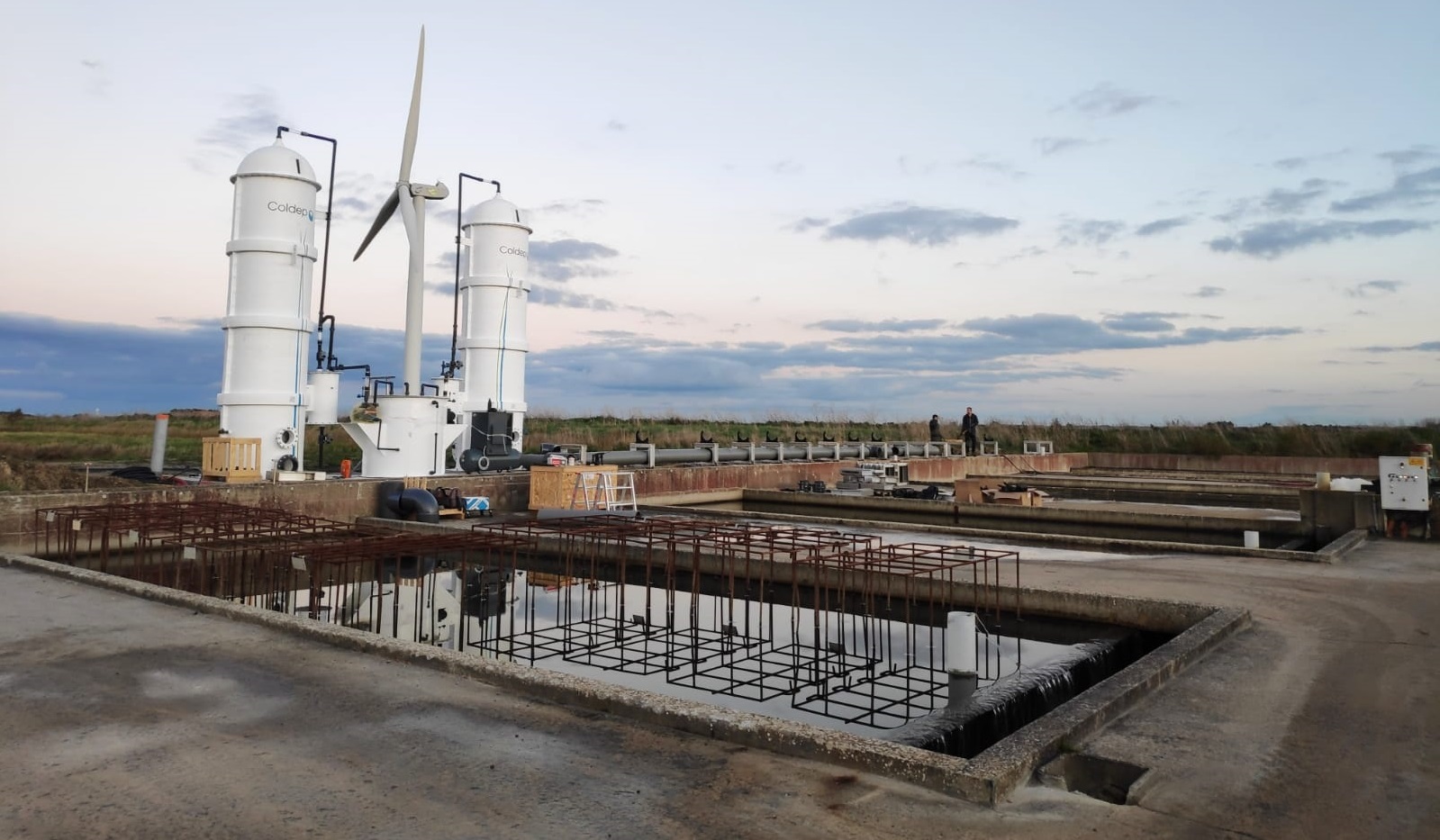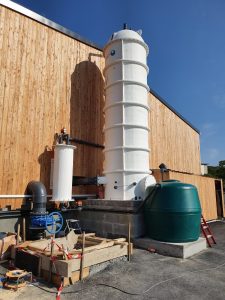[ad_1]
Created twelve years ago, Coldep brings an innovation that represents a breakthrough technology in the field of water treatment. Called Vacuum AirLift, the three-in-one process proves to be particularly efficient, energy efficient, uses little land space and also makes it possible to obtain recoverable material. Historically anchored in the aquaculture sector, cleantech is now exploring other avenues, such as the treatment of industrial effluents, and is also carrying out several research projects. After the announcement, recently, of a fundraising of €1 million, Coldep took advantage of its presence a few days ago in the Innovation Village of the CYCL’EAU Provence-Alpes show. Méditerranée to present its latest advances, its demonstrator, and develop its partnerships.
VAL. Three letters behind which hides a truly disruptive technology, an innovative process for water treatment, protected by two patents: Vacuum AirLift. Today supported by the Montpellier company Coldepthe innovation was born a dozen years ago from the intuition of Julien Jacquety and Bertrand Barrut, then respectively an engineering student and PhD student. Sensing the possibility of treating and recycling water used in a closed circuit in the field of aquaculture via a vacuum particle extraction column system, the two scientists embarked on tests, which they carried out in collaboration with two teacher-researchers from renowned institutes, INSA Lyon et Ifremer. “Quickly, they realized that it worked! »traces the man who joined the Coldep adventure last June to become its general director, Sébastien Latz. “Bertrand Barrut was then responsible for co-drafting the patents, while Julien Jacquety set about creating the company”, continues the CEO of Coldep. Prototyping and testing work followed, which led a few years later – around eight years ago – to the industrialization of the solution. “A strategic partnership was then established with the Moroccan company Omega responsible for producing the central element of the system: the column”reveals Sébastien Latz.
Since then, Coldep has multiplied its installations, so much so that it has now reached the milestone of a hundred sites – mainly aquaculture – equipped with its technology with multiple virtues.

A virtuous technology… and three-in-one
Inefficient in terms of energy and land – thanks to its columns with a height of four to six meters for a footprint of only one to four square meters – the Vacuum AirLift also ensures three key functions in the treatment of the water “historically provided by three distinct technologies”as Sébastien Latz notes.
The first of these is particle extraction, which makes it possible to remove mineral matter present in suspension in water, as well as organic particles: viruses, bacteria and other microalgae. The second concerns the rebalancing of gases dissolved in the water, ensuring its oxygenation. The third, finally, is of a mechanical nature: by setting in motion the masses of water that it involves, VAL technology makes it possible to do without a good part of the pumps hitherto essential for water treatment installations. water treatment. Its basic principle consists of partial vacuuming of the centerpiece of the technology – the column – associated with an injection of air. Conditions which will then mechanically lead to hydraulic circulation. The VAL thus makes it possible, according to the figures put forward by Coldep, to reduce by three to five times (depending on the configuration and the targeted treatment objectives) the electrical consumption linked to the movement of the water to be treated, compared to to conventional pumping equipment. All this, with flow rates of up to several hundred m3/h.
Unwanted particles concentrated in a foam
The injection of compressed air also causes the formation of air microbubbles, capturing particles suspended in the water as they pass and finally bringing them to the top of the column. A foam then gradually forms there, under the action of this process known as “foaming-skimming”. “This function is probably one of the most interesting in our technology. It makes it possible to obtain a very concentrated residual material, which we extract by suction thanks, once again, to the evacuation of the column., explains Bertrand Barrut himself, today R&D director of Coldep. The vacuum thus replaces the scraping operations involved in conventional foaming-skimming approaches. “The benefit is twofold: on the one hand it allows the extraction of a highly dehydrated concentrate, which therefore occupies a smaller volume, but also on the other hand it ensures total extraction of the concentrate, without any stagnation”adds Bertrand Barrut.

This, moreover, without using any filter or other consumable and with record efficiency: “It is possible to filter water with a result of less than three SDI[1] (water clogging index) in a few hours, concentrate suspended particles up to one hundred times, and eliminate more than 99% of particles present in water, including the majority of dissolved organic matter , oils and hydrocarbons, all without the use of chemical additives”, Coldep in fact argues in his press kit.
A recoverable concentrate
Mentioned above by Bertrand Barrut, the very low hydration of the concentrate also represents a significant advantage in terms of its valorization. “Its dryness index, which reflects its level of dehydration, is nearly twice that of a concentrate obtained via more conventional foaming-skimming approaches”, assures Sébastien Latz. Rich in organic matter, the material extracted from water using Coldep’s VAL process can easily be recycled, for example in methanization. However, this possibility remains difficult to envisage in the context of the historic market for the deployment of Coldep technology, which is aquaculture, as Sébastien Latz concedes.
In addition to treating water from shellfish farms and other fish farming facilities, the Montpellier-based company recently chose to also explore, in parallel, the path of treatment of industrial effluents. An area in which the extracted materials can this time indeed be valorized, in particular by methanization. “For example, we have equipped the production site of a food industry with our technology, with the aim of treating water resulting from the transformation of food into prepared meals. This allowed it to obtain a new recoverable material, to the tune of around 300 tonnes per year”welcomes Sébastien Latz. “While it was only a cost center for manufacturers, the management of their effluents can thus become, if not profitable, in any case much less expensive than before”adds the CEO of Coldep.
In terms of costs, if the initial investment is more or less comparable to that of more conventional treatment installations, the amounts necessary to operate the Coldep solution turn out to be lower according to the company. : less energy consuming, its VAL technology also requires neither filter changes nor replacement of wearing parts, which also means less maintenance times. “Our technology is also highly automated, and therefore requires less human intervention”underlines Sébastien Latz.
Many future prospects
Beyond aquaculture and now industrial effluent, Coldep also plans to explore the path of reuse of waste processed (REUT), as its general director reveals: “We have already carried out a project at the Luma Foundation, which aimed to treat all the gray and yellow water on the site, with a view to reusing it for irrigation needs”.
Even more prospectively, Coldep is also interested in the subject of pre-treatment of seawater before desalination, or in an innovative approach to combating CO₂ emissions: algo-bioremediation. “This refers to the act of capturing CO₂ from industrial fumes through algae, whose carbon dioxide boosts growth”, explains Sébastien Latz. Coldep is thus involved on this level in the series of projects VASCOthe third iteration of which was launched in 2022. “We are one of the six partners of the VASCO3 project, which aims to take the tests we are carrying out in this area to a more industrial scale”, explains the CEO of Coldep. The Montpellier company is also among the players in the Portuguese project REDWinewhich aims to capture, again through the cultivation of algae, the CO₂ resulting from the alcoholic fermentation process.
To carry out all these projects, Coldep can count on the funds it recently raised: €1 million, as she announced on November 6. A sum that the company, now with a team of eleven employees, also intends to use to recruit, but also to develop mobile demonstrators which can be brought on site in order to demonstrate the relevance of the technology to potential industrial customers. “Our fundraising also aims to make our VAL technology as autonomous as possible, by developing remote control possibilities, in particular through a very easy-to-access application which will constitute a sort of digital twin of each installation”finally projects Sébastien Latz.
Very confident in its technology, the CEO of Coldep assures that the company is only beginning to explore the new markets it is targeting… Montpellier cleantech is therefore counting on “engineers who want to change the world” to help it continue its pioneering spirit, strengthen its environmental commitment in the field of water treatment, but also to fight against climate change.
[1] Silt density index.
[ad_2]
Source link